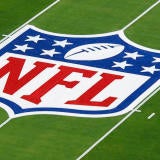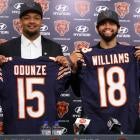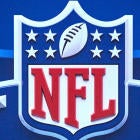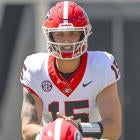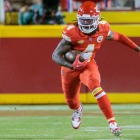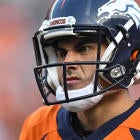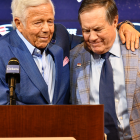Almost every year, teams desperate for quarterbacks talk themselves into trading up in the draft to get the guy they're suddenly convinced can right a listless franchise. It almost never (ever, ever) works, and teams that find themselves picking early in one draft after the next seem slow to learn from history.
There are exceptions of organizations coming off down seasons, moving up to take a quarterback, and suddenly winning football games. But more often than not, trading up is a fool's errand.
Last month, three teams in three very different predicaments took the plunge. The 3-13 Bears have redefined hopeless; for them, Mitchell Trubisky feels like their "any port in the storm" quarterback. The Chiefs and Texans, meanwhile, are playoff teams with players in place to help their rookie quarterbacks succeed.
But before we look ahead, it's instructive to take a look back, starting with the 2008 NFL Draft.
2008: Ravens trade up for Joe Flacco
The trade: The Ravens began the 2008 NFL Draft with the eighth overall pick. In a deal with the Jaguars, the Ravens moved from No. 8 to No. 26 (Jacksonville took pass rusher Derrick Harvey), and then in a swap with the Texans, moved up from No. 26 to No. 18. Houston took left tackle Duane Brown 26th overall and Baltimore took Flacco, the former Pitt quarterback who transferred to Delaware after not finding playing time behind Tyler Palko.
Before and after: The Ravens finished the 2007 season with a 5-11 record. Steve McNair began the year under center and he went 2-4 in six starts. Kyle Boller started eight games (he went 2-6), and rookie Heisman Trophy winner Troy Smith was 1-1 in two starts. Baltimore selected Boller in the first round of the 2003 NFL Draft, but he struggled with consistency during his five years with the Ravens. McNair retired following the '07 season and Boller won the starting job ahead of the rookie Flacco during the '08 preseason. But an injury in a preseason game forced him to injured reserve and paved the way for Flacco, who would go on to start 122 consecutive games before an ACL injury forced him to the sidelines in 2015.
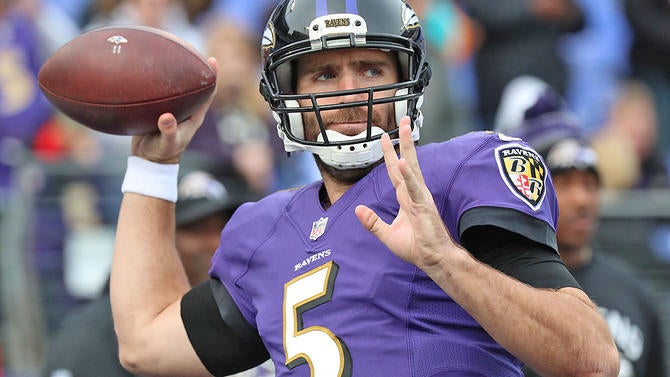
Was it worth it? Absolutely. In the four seasons before Flacco arrived, the Ravens won nine, six, 13 and five games. With Flacco under center, and coach John Harbaugh replacing Brian Billick, the Ravens made five straight playoff appearances, and oh yeah, they won Super Bowl XLVII following the 2012 season. Flacco and the Ravens have struggled in recent years, though it's not entirely the quarterback's fault. The defense hasn't been nearly as dominant, the offense has lacked playmakers and, as we mentioned above, Flacco suffered a serious knee injury. Still, all things considered, it's hard to imagine that the front office wouldn't make the same deal if they knew it would result in a Lombardi Trophy.
To recap: (Details courtesy of the invaluable ProSportsTransactions.com) Here's what the Ravens got to move down ...
Jaguars traded 2008 first-round pick (No. 26, Duane Brown), two 2008 third-round picks (No. 71, Tavares Gooden) (No. 89, Steve Slaton), 2008 fourth-round pick (No. 125, Arman Shields) to the Ravens for 2008 first-round pick (No. 8, Derrick Harvey).
When the Ravens moved up ...
Ravens traded 2008 first-round pick (No. 26, Duane Brown), 2008 third-round pick (No. 89, Steve Slaton), 2008 sixth-round pick (No. 173, Dominique Barber) to the Texans for 2008 first-round pick (No. 18, Joe Flacco).
2009: Jets trade up for Mark Sanchez
The trade: The Jets had the No. 17 pick, but desperate for a quarterback in a post-Favre world, first-year coach Rex Ryan and general manager Mike Tannenbaum swung a deal with the Browns to move up to fifth overall and draft Sanchez, who left Southern California after his junior season. At the time, then-USC coach Pete Carroll thought Sanchez needed another year in college.
"The facts are so strong against this decision," Carroll said at the time of Sanchez choosing to enter the draft. "After analyzing all the information, the truth is there, he should have stayed for another year. He lost out on a chance to fully prepare himself. The facts are there's a 62 percent failure rate for underclassmen quarterbacks."
Turns out, Carroll was onto something.
Before and after: The Jets were 9-7 in 2008 but missed the playoffs. Favre, who had started strong but faded down the stretch in his one year with the Jets, told the team he was going to retire. Coach Eric Mangini was fired, and the team was suddenly in need of a franchise quarterback. The good news: The Jets were immediately successful with Ryan on the sidelines and Sanchez under center. The team went to back-to-back AFC Championship Games, though it's easy to make the case that that was in spite of Sanchez, who was the beneficiary of one of the league's most tenacious defenses and a solid running game. From 2011-2013, the Jets were 22-26 and didn't have a winning season, and when Sanchez suffered a shoulder injury on a meaningless series during the '13 preseason, that effectively ended his time with New York. He was released the following offseason and has been on the roster of four different teams since.
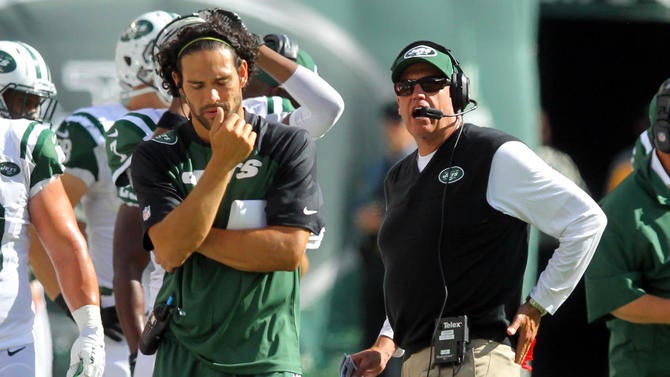
Was it worth it? If you consider that the Jets were a game away from the Super Bowl in Sanchez's first two seasons, then hell yeah. The team had last made the playoffs in 2006, and they haven't made it since 2010. They also remain on the hunt for their next franchise quarterback, having drafted Geno Smith in the second round in 2013, Bryce Petty in the fourth round in 2014 and Christian Hackenberg in the second round in 2016.
Of course, without Sanchez there is no Butt Fumble.
To recap: (via ProSportsTransactions.com) Here's what the Jets gave up to move from No. 17 to No. 5 ...
Jets traded Kenyon Coleman, Brett Ratliff, Abram Elam, 2009 first-round pick (No. 17, Josh Freeman), 2009 second-round pick (No. 52, David Veikune) to Browns for 2009 first-round pick (No. 5, Mark Sanchez).
2009: Buccaneers trade up for Josh Freeman
The trade: The Bucs had the No. 19 pick, but with Raheem Morris replacing Jon Gruden, and the team choosing not to re-sign Jeff Garcia, quarterback became a priority. The Browns, who found themselves with the 17th overall pick (see above), happily moved down two spots so Tampa Bay could get its guy, Kansas State's Josh Freeman.
Before and after: The Bucs were 9-7 in Gruden's final two seasons with Garcia making 24 starts. In Year 1 of the Morris-Freeman era, Tampa Bay limped to a 3-13 record and Freeman ranked 40th in total QB value, according to Football Outsiders' metrics. Things got better in 2010; the Bucs went 10-6 (but didn't make the playoffs) and Freeman completed 61 percent of his throws for 25 touchdowns and just six interceptions. He struggled in '11 (16 TDs, 22 INTs) and Tampa won four games. The team was 7-9 in 2012 and three games into the 2013 season, Freeman was benched for rookie Mike Glennon. The Bucs cut Freeman a few weeks later. He finished the year with the Vikings, bounced around for a year and a half -- including a stint with the FXFL's Brooklyn Bolts -- and ended up starting the final game of the 2015 regular season for the Colts. He was released three months later and has been out of football ever since.
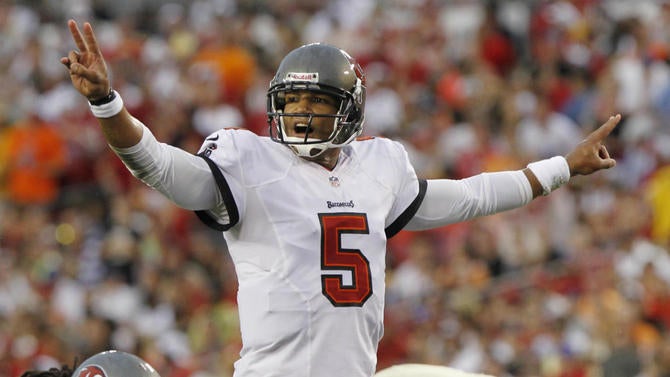
Was it worth it? No, at least in the sense that Freeman didn't work out. But the Bucs didn't give up much to move up two spots to take a chance on a guy they really liked heading into the draft. Franchise quarterbacks are hard to find, and the days of winning Super Bowls with a stifling defense and Brad Johnson were long gone. Freeman was a bust, but it's hard to fault Tampa Bay for taking the risk.
To recap: (via ProSportsTransactions.com) Here's what the Buccaneers gave up to move from No. 19 to No. 17 ...
Buccaneers traded 2009 first-round pick (No. 19, Jeremy Maclin), 2009 sixth-round pick (No. 191, Coye Francies) to Browns for 2009 first-round pick (No. 17, Josh Freeman).
2010: Broncos trade up for Tim Tebow
The trade: The Broncos began the 2010 NFL Draft with the No. 14 pick, but traded down to No. 24 and then traded up to No. 22 to take Demaryius Thomas. Jackpot. But three picks later, the Broncos traded back into the first round to grab Tebow. This was Josh McDaniels' second year as coach, and after winning six straight games to start 2009, the team limped to an 8-8 finish. Looking to make a splash, Thomas and Tebow -- in addition to third-rounder Eric Decker -- were all drafted to jump-start an offense that stalled during the second half of the '09 season.
Before and after: Good news: 6-0 start! Bad news: 2-8 finish! McDaniels also shipped Jay Cutler out of town before the '09 season, and while Kyle Orton was serviceable, he wasn't the long-term answer. Neither, it turns out, was Tebow, who was 1-2 as a starter as a rookie. McDaniels was fired midway through that season (Denver finished 4-12), and his replacement, John Fox, faced mounting pressure in 2011 and by Week 7 he had named Tebow the starter. Against all odds, Tebow found unique and exciting ways to win games and not only was 7-4 as a starter, but he also beat the Steelers in the wild-card game.

Was it worth it? If nothing else, that 2011 season was a wild scene, man. It probably wasn't great to live through if you were Fox -- or Orton -- but the Broncos made the playoffs for the first time since 2005. Of course, general manager John Elway, who knows something about playing quarterback, wasn't convinced of Tebow's future, dumped him on the Jets and promptly signed Peyton Manning, who led Denver to four straight postseason appearances, including a Super Bowl 50 title. Trading up for Tebow probably isn't on McDaniels' CV under "accomplishments," but it's also not the worst deal he made while in Denver; in 2009, he traded up in the second round to take Wake Forest cornerback Alphonso Smith, who almost immediately became a bust. In order to do that, McDaniels' sent the Broncos' 2010 first-rounder to the Seahawks. They eventually drafted some kid named Earl Thomas.
To recap: (via ProSportsTransactions.com) Here's what the Broncos gave up to move to No. 25 ...
Broncos traded 2010 second-round pick (No. 43, Sergio Kindle), 2010 third-round pick (No. 70, Ed Dickson), 2010 fourth-round pick (No. 114, Dennis Pitta) to Ravens for 2010 first-round pick (No. 25, Tim Tebow).
2011: Jaguars trade up for Blaine Gabbert
The trade: The Jaguars began the 2011 NFL Draft with the No. 16 pick, but they were intent to move on from David Garrard, which prompted their move up the draft board to get Gabbert. With Cam Newton (first overall) and Jake Locker (eighth overall) already off the board, the Redskins, who had the No. 10 pick, were willing partners.
Before and after: The Jags last hadn't made the playoffs since 2007 and had gone 7-9 in 2009 and 8-8 in '10. Despite a resurgence of sorts for Garrard, who made 30 starts with 38 touchdowns and 25 interceptions during those final two seasons, the Jaguars and coach Jack Del Rio were determined to get younger at the position. Garrard was cut just before the 2011 season opener and never took another regular-season snap.
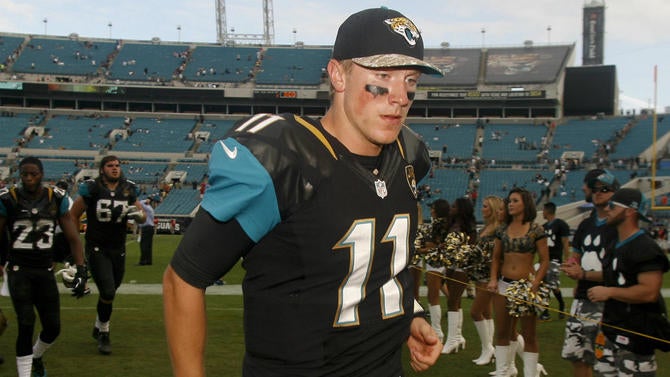
Turns out, moving on from Garrard was the beginning of the end for not just Del Rio, who was canned midway through Gabbert's rookie season, but the Jaguars, who haven't won more than five games since 2011. It also didn't help that Gabbert had little to no help around him; he started 24 games during his first two years and went 5-19. Injuries limited him to three games in 2013, and in March 2014 he was traded to the 49ers in exchange for a sixth-round pick. A change of scenery didn't change the fact that he was a replacement-level quarterback, and after three mostly forgettable seasons in San Francisco, Gabbert is now on the Cardinals' roster.
Was it worth it? In a vacuum, no. But other than Newton, that year's first-round quarterbacks proved to be not very good; Locker retired and Gabbert and Christian Ponder (12th pick) weren't legit starters. Andy Dalton, taken early in Round 2, has been successful in Cincinnati, but even the player taken with the very next pick -- Colin Kaepernick -- has seen his stock plummet after several years of uneven play. Given that J.J. Watt was selected one pick after Gabbert, it's fair to say that the Jags would like a do-over.
To recap: (via ProSportsTransactions.com) Here's what the Jaguars gave up to move from No. 16 to No. 10 ...
Jaguars traded 2011 first-round pick (No. 16, Ryan Kerrigan), 2011 second-round pick (No. 49, Ben Ijalana) to Redskins for 2011 first-round pick (No. 10, Blaine Gabbert).
2012: Redskins trade up for Robert Griffin III
The trade: Hoo boy. Remember how excited Mike Shanahan was about moving up to take Griffin? In the long run, it cost the Redskins quite a cache of talent, as you can see below. And the early returns were justified -- RG3 helped the Redskins win their final seven regular-season games to take the division and qualify for the playoffs in his rookie season. But a late-season knee injury was made worse in a wild-card loss to the Seahawks and, well, it's safe to say thing went straight downhill from there.
Before and after: From 2008-11, the Redskins had Jason Campbell, Donovan McNabb and Rex Grossman under center. Not surprisingly, the team didn't post a winning record once during that stretch, so it's easy to see why Shanahan was itching to get a new face of the franchise. The dream lasted one season before the nightmare began promptly as Griffin hobbled off the field following the team's January 2013 playoff loss to the Seahawks.
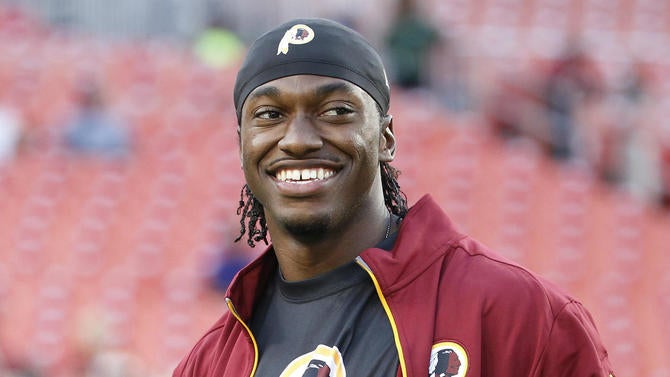
Griffin didn't take part in offseason workouts while he rehabbed after his rookie-season injury. He still started the 2013 regular season but looked nothing like the reigning Offensive Rookie of the Year. The team went 3-13, Shanahan lost a power struggle with Griffin and was fired. New coach Jay Gruden never seemed comfortable with how Griffin's game fit his offense. After going 2-5 in seven starts in 2014 and losing the job to Kirk Cousins (who, incidentally, was a fourth-round pick in that very same 2012 draft), Griffin wasn't signed and he ended up in Cleveland. After one injury-plagued season there, he was cut this offseason and currently remains out of work.
Was it worth it? Nope. For a glimpse as to why, consider this tweet from almost two years ago:
Since this will again be a big storyline this week, here's a full breakdown of "the trade." pic.twitter.com/fC6OmXHOoD
— Casey Pearce (@ccpearce) September 15, 2015
Granted, the Rams remain horrible, but that doesn't change the fact that the Redskins gave up a lot for very little. If you're a Redskins fan and want to make yourself feel better, just imagine that the team traded up for Cousins and took Griffin with that fourth-round pick. Better? No? Moving on ...
2014: Browns trade up for Johnny Manziel
The trade: The Browns had two first-round picks -- originally Nos. 4 and 26, but after much wheeling and dealing they ended up taking cornerback Justin Gilbert eighth overall and trading up from 26 to 22 to take Johnny Football. Needless to say, the decision to draft the Heisman Trophy winner was a controversial one.
Here's former team president Joe Banner last month, discussing the decision to take Manziel:
"To be completely candid, at that point [three months before the 2014 draft] he wasn't on the board," Banner said. "I should be careful in saying this, because we had people in the building who liked Manziel. ... Our attitude at that point was we weren't comfortable with the risks that came with Johnny and we weren't going to pick him. So we didn't really have him stacked at that point."
So what happened? Well, if you believe owner Jimmy Haslam, he might have been convinced to pull the trigger by a homeless man.
"Here in Cleveland, everywhere I go people know me," ESPN's Sal Paolantonio reported Haslam said shortly after the '14 draft. "And I was out to dinner recently and a homeless person was out on the street, looked up at me and said, 'Draft Manziel.'"
Fun fact: The Browns reportedly spent $100,000 on a study that said Teddy Bridgewater was a better NFL prospect than Manziel only to have Haslam trade up to take Johnny Football.
Before and after: Good news: Manziel isn't the reason the Browns have been terrible for nearly two decades. Consider this: Since returning to Cleveland in 1999, the Browns have had exactly two winning seasons; in 2002 when Kelly Holcomb was quarterback, and in 2007 when Derek Anderson was quarterback. They combined to win nine games in the two years before Manziel arrived, won seven games during Manziel's rookie season, and have won four games since. The Browns cut Manziel in March 2016. In 15 games, he completed 57 percent of his passes with seven touchdowns and seven interceptions.
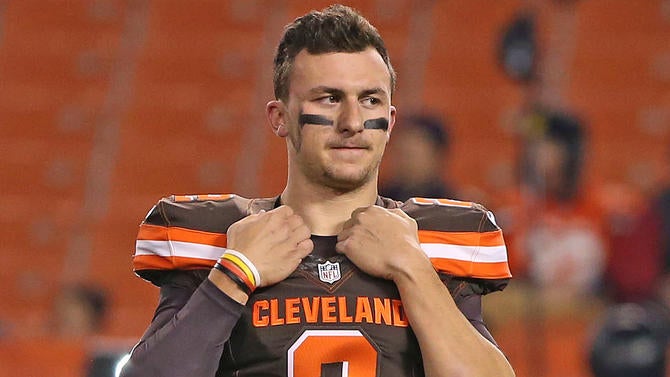
Was it worth it? No. The Browns could've drafted Odell Beckham instead of Gilbert (who was later traded to the Steelers for a sixth-round pick and is currently a free agent) and taken Bridgewater over Manziel.
To recap: (via ProSportsTransactions.com) Here's what the Browns gave up to move from No. 26 to No. 22 ...
Traded 2014 first-round pick (No. 26, Marcus Smith), 2014 third-round pick (No. 83, Louis Nix III) to Eagles for 2014 first-round pick (No. 22, Johnny Manziel).
2014: Vikings trade up for Teddy Bridgewater
The trade: The Vikes traded down from No. 8 to No. 9 and took outside linebacker Anthony Barr and then, at the very end of the first round, traded back in to grab Bridgewater. He was considered one of the top college prospects in the fall, but poor workouts (real or imagined) saw him slip down draft boards.
Before and after: The Vikings whiffed on Christian Ponder two years earlier. And it wasn't surprising that coach Mike Zimmer, who was replacing Leslie Frazier, would want to handpick his quarterback. The Vikes made the playoffs in 2012, mostly because of Adrian Peterson and the running game with Ponder playing at replacement level. But he struggled in 2013, and the team won just five times. By '14, he was effectively a third-stringer behind Bridgewater and Matt Cassel. Minnesota went 7-9 during Bridgewater's rookie season; in 13 games he completed 65 percent of his throws with 28 touchdowns and 21 interceptions, and they improved to 11-5 in 2015 when Bridgewater again completed 65 percent of his throws with 14 touchdowns and nine interceptions. But a horrific knee injury in August 2016 not only ended Bridgewater's 2016 season but imperiled his career.
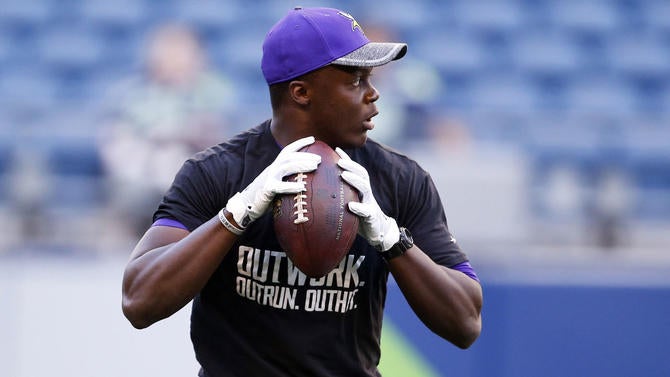
The Vikings tweeted images of Bridgewater on the field working out during OTAs on Tuesday but it remains unclear when he'll be cleared to play again.
Was it worth it? Yep. Bridgewater improved from Year 1 to Year 2, helped his team to the playoffs, and was expected to make another jump in productivity in Year 3 before the freak knee injury. The alternative at the time -- sticking with Ponder or rolling with Cassel -- remains unattractive even knowing what we now know.
To recap: (via ProSportsTransactions.com) Here's what the Vikings gave up to move to No. 32 ...
Vikings traded 2014 second-round pick (No. 40, Kyle Van Noy), 2014 fourth-round pick (No. 108, Cassius Marsh) to Seahawks for 2014 first-round pick (No. 32, Teddy Bridgewater).
2016: Rams trade up for Jared Goff
The trade: The Rams were desperate for a franchise quarterback, and coach Jeff Fisher was desperate to change his fortunes. So he and general manager Les Snead moved all the way from No. 15 to first overall because they were convinced Goff was the future. Fisher didn't finish out the 2016 season; he was fired less than 24 hours after the the Falcons throttled the Rams 42-14 in Week 14. Of course, Goff spent the first 10 weeks on the bench, and when he made his debut against the Dolphins on Nov. 20 it wasn't pretty (17 of 31, 134 yards, 0 TDs, 0 INTs). It also wasn't entirely his fault; the Rams' offense was stagnant, the defense was a mess and Fisher already had one foot out the door.
Before and after: The Rams' last winning season came in 2003, when Mike Martz was coach and Marc Bulger was the quarterback. Under Fisher, who was hired before the 2012 season, the Rams went 31-45-1, never won more than seven games and never made the playoffs. Quarterbacks of note during the Fisher era included Sam Bradford, Austin Davis, Nick Foles and Case Keenum. The Rams finished 4-12 last season, with Goff starting the final seven games. He went 0-7.
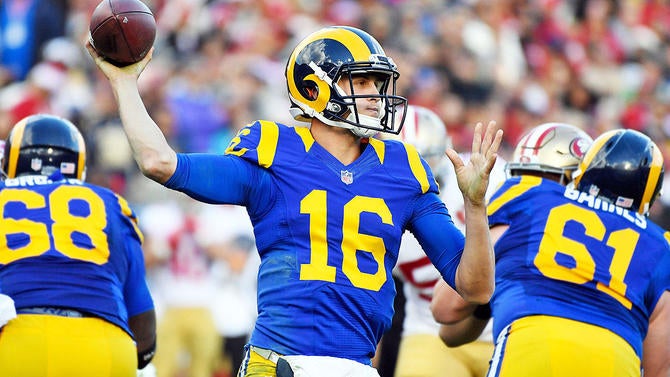
Was it worth it? It sure doesn't seem like it, and that assessment isn't solely because Goff struggled. Recent history should've clued Fisher and Snead in, partly because they were on the other end of a blockbuster draft trade -- scroll up and re-read the Robert Griffin III section.
.@ESPNStatsInfo's list of QBs acquired via trades into the top-5 since 1990: RG3, Sanchize, Mike Vick, Ryan Leaf, Kerry Collins, Jeff George
— Bill Barnwell (@billbarnwell) April 14, 2016
But desperation is a stinky cologne, and it cost Fisher his job. Now it's up to quarterback guru Sean McVay, 31 years old and hired in the offseason, to get the most out of Goff.
To recap: (via ProSportsTransactions.com) Here's what the Rams gave up to move from No. 15 to No. 1 ...
Rams traded 2016 first-round pick (No. 15, Corey Coleman), 2016 second-round pick (No. 43, Austin Johnson), 2016 second-round pick (No. 45, Derrick Henry), 2016 third-round pick (No. 76, Shon Coleman), 2017 first-round pick (No. 5, Corey Davis), 2017 third-round pick (No. 100, Jonnu Smith) to Titans for 2016 first-round pick (No. 1, Jared Goff), 2016 fourth-round pick (No. 113, Nick Kwiatkoski), 2016 sixth-round pick (No. 177, Temarrick Hemingway).
2016: Eagles trade up for Carson Wentz
The trade: It happened a week before the 2016 NFL Draft; the Eagles moved up from No. 8 to No. 2 to position themselves for Wentz. (A month before, Philadelphia sent Byron Maxwell, Kiko Alonso and the 13th overall pick in 2016 to Miami for the Dolphins' No. 8 pick.) At the time, Eagles coach Doug Pederson called Goff and Wentz "pretty even in my opinion," but Goff ended up going first overall to the Rams and Wentz was on the board at No. 2.
Before and after: Andy Reid was fired in 2012 after going 4-12 with Michael Vick under center. Chip Kelly was hired to revolutionize the NFL game, and that lasted a few months before the rest of the league caught up. Vick, then Nick Foles and then Mark Sanchez and then Sam Bradford all played quarterback under Kelly, who went 10-6 in his first two seasons before slipping to 6-9 in 2015. He was fired before the season finale. In Wentz's rookie season -- with rookie coach Doug Pederson -- the Eagles went ... 7-9. Wentz started fast by going 3-0, including dominating the Steelers in a Week 3 game where he completed 74 percent of his passes for 301 yards, two touchdowns, no turnovers and a QB rating of 125.9. But he struggled down the stretch, going 2-5 over the final two months, throwing seven touchdowns and nine picks in that time.
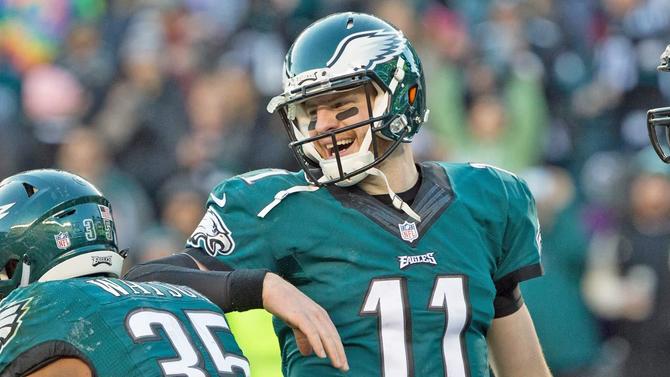
Was it worth it? It's too early to say. Initially, Wentz, who played at North Dakota State in the FCS, looked like the real deal, but as often happens with rookies learning to adjust to the NFL game, he hit a rough patch and never really recovered. The Eagles could've decided not to make the deal to move up for Wentz and taken Dak Prescott, who went in Round 4, but nobody -- Prescott included -- thought he would have the season he did.
To recap: (via ProSportsTransactions.com) Here's what the Eagles gave up to move from No. 8 to No. 2 ...
Eagles traded 2016 first-round pick (No. 8, Jack Conklin), 2016 third-round pick (No. 77, Daryl Worley), 2016 fourth-round pick (No. 100, Connor Cook), 2017 first-round pick (No. 12, Deshaun Watson), 2018 second-round pick to Browns for 2016 first-round pick (No. 2, Carson Wentz), 2017 fourth-round pick (No. 139, Jehu Chesson).
2016: Broncos trade up for Paxton Lynch
The trade: The Broncos moved up five spots from No. 31 to No. 26 to take Lynch. Peyton Manning had won the Super Bowl in February and retired in March, Brock Osweiler bolted for the Texans and the Broncos were left with 2015 seventh-rounder Trevor Siemian and journeyman Mark Sanchez. All told, Lynch made a lot of sense.
Before and after: Since Manning's arrival in 2012, the Broncos were 50-14, made the playoffs all four seasons and won Super Bowl 50 as Manning rode off into the sunset. The good news was that the pieces were in place for whoever succeeded Manning. That turned out to be Sieman, primarily, who went 8-6 in 14 starts (59.5 completion percentage, 18 TDs, 10 INTs). Lynch did get two starts and he went 1-1 with a 59 completion percentage, two touchdowns and an interception.
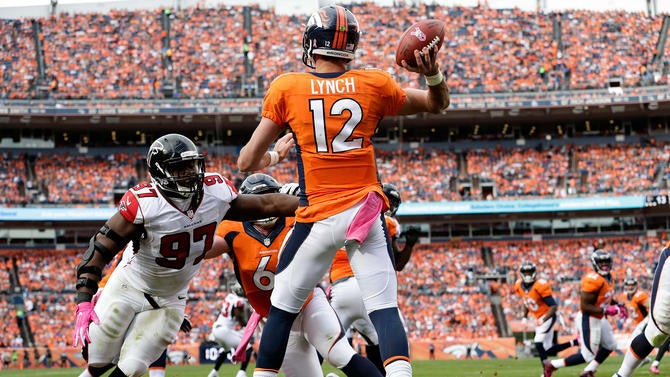
Was it worth it? Way too early to tell. Siemian and Lynch will battle for the starting job in 2017 in training camp. The Broncos also used the final pick of the 2017 NFL Draft on Chad Kelly, who first-year coach Vance Joseph described as "my favorite quarterback in the draft."
To recap: (via ProSportsTransactions.com) Here's what the Broncos gave up to move from No. 31 to No. 26 ...
Broncos traded 2016 first-round pick (No. 31, Germain Ifedi), 2016 third-round pick (No. 94, Nick Vannett) to Seahawks for 2016 first-round pick (No. 26, Paxton Lynch).
Which brings us to the 2017 NFL Draft. Three teams swung deals to move up and get "their guy," but it's impossible to weigh in on how these quarterbacks will perform this season and beyond. In case you're wondering, however, here's what each team gave up in return for their QB of the future:
1. Bears move up to No. 2 from No. 3 for Mitchell Trubisky: The Bears traded 2017 first-round pick (No. 3, Solomon Thomas), 2017 third-round pick (No. 67, Alvin Kamara), 2017 fourth-round pick (No. 111, Tedric Thompson), 2018 third-round pick to 49ers for 2017 first-round pick (No. 2, Mitchell Trubisky).
Reactions to the deal range mostly from not liking it to outright hating it, but if Trubisky can become the savior of Bears football, the price will be a minor footnote in franchise history.
Last season: 3-13. Jay Cutler, Brian Hoyer and Matt Barkley all started at least five games and all won once. All three have also moved on, and the team signed Mike Glennon to a $45 million deal the month before drafting Trubisky.
2. Chiefs move up from No. 27 to No. 10 for Pat Mahomes: The Chiefs traded 2017 first-round pick (No. 27, Tre'Davious White), 2017 third-round pick (No. 91, John Johnson), 2018 first-round pick to Bills for 2017 first-round pick (No. 10, Patrick Mahomes).
Like the Broncos in 2016, the Chiefs have the pieces in place for Mahomes to be successful. Kansas City also has Alex Smith, who can hold down the job for another year or two.
Last season: 12-4 and a first-round bye. The Chiefs lost to the Steelers in the AFC divisional round. Smith started 15 games, went 11-4 and completed 67 percent of his throws with 15 touchdowns and eight interceptions.
3. Texans move up from No. 25 to No. 12 for Deshaun Watson: The Texans traded 2017 first-round pick (No. 25, Jabrill Peppers), 2018 first-round pick to Browns for 2017 first-round pick (No. 12, Deshaun Watson).
Brock Osweiler, signed a year ago to a four-year, $72 million deal, was an unmitigated disaster. He was traded to the Browns earlier in the offseason, paving the way for Watson, who will battle Tom Savage for the starting gig.
Last season: 9-7 and AFC South champs. That playoff berth came despite Osweiler, who started 14 games, won eight of them, and completed 59 percent of his throws with 15 touchdowns and 16 interceptions.









